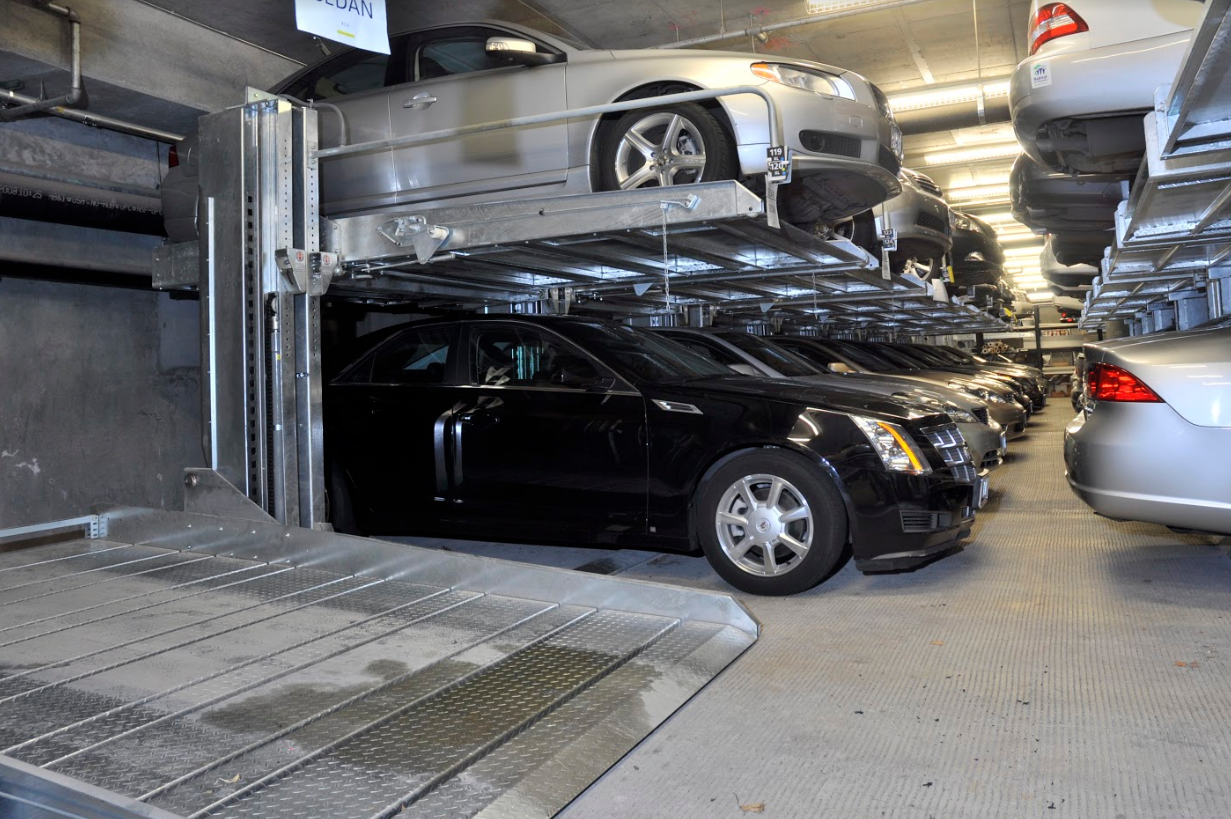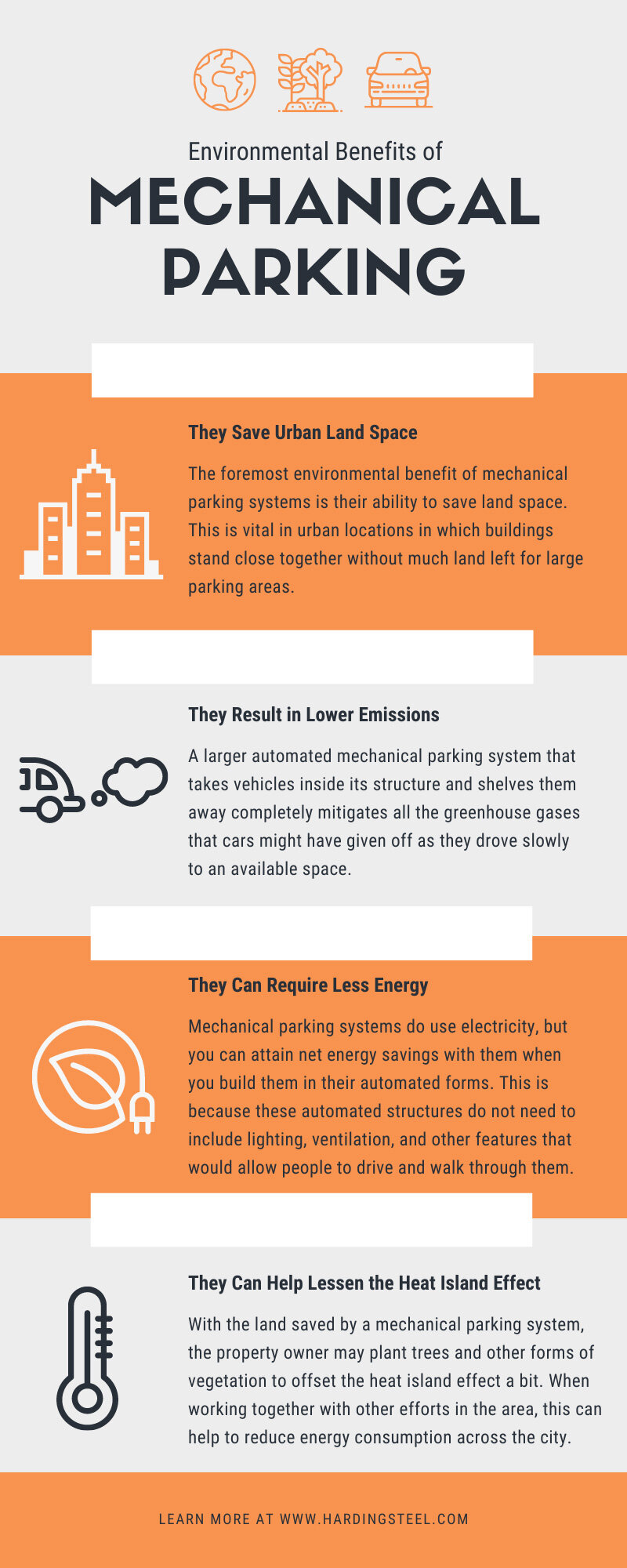Mechanical parking describes modern systems that store vehicles within moving spaces. It may be as simple as a singular platform that can move up and down to create an extra spot above the normal parking spaces. It also includes systems that rotate several platforms in horizontal or vertical circuits above or below ground. The most extensive mechanical parking systems function like giant shelves wherein cars rest on a platform that moves from an entrance area to any location within the shelves for automobile storage and retrieval. Certainly, all these systems provide creative ways to add parking spots to a set area—but that is not all. There are also some environmental benefits of mechanical parking that a city, company, or other land-owning organization may benefit from when they implement it. You can see how such systems are better for the environment than traditional parking lots and garages through the following points.
They Save Urban Land Space
The foremost environmental benefit of mechanical parking systems is their ability to save land space. This is vital in urban locations in which buildings stand close together without much land left for large parking areas. It is common for sizeable commercial buildings to have parking garages, which architects direct upward since they cannot spread laterally. Sometimes, people fill these garages to maximum capacity while others are still trying to get in. Smaller businesses, houses, and apartment complexes may lack dedicated parking altogether. People must then vie for spots in the streets.
When there is not enough parking, vehicles spend more time moving around a city, using up energy and contributing to air pollution as they search for an available space. Different types of mechanical parking systems help counteract this effect by providing more parking spots within a smaller piece of land than other parking arrangements. It can add new spaces above grounded ones, even within individual levels in a garage, or it can shelve cars more compactly than would be possible if a driver had to maneuver into a space themselves.
They Result in Lower Emissions
Providing more spaces with less land reduces air pollution that drivers may create outside the parking area. But the enactment of mechanical parking can also result in lower emissions within its space. Vehicles would normally use up fuel and disperse emissions as they slowly move through a garage where people, other vehicles, and walls make immediate safety a higher priority than environmental concerns. A larger automated mechanical parking system that takes vehicles inside its structure and shelves them away completely mitigates all the greenhouse gases that cars might have given off as they drove slowly to an available space.
In addition, there are instances where people may sit and wait in their cars without ever entering the corresponding building. To stay comfortable, they often leave their engines running so that they have access to air conditioning or heating. All the while, they release pollution as a byproduct. Simple mechanical stack parking and more complex semi-automated and automated parking systems can stop all of this from happening and, thereby, aid the environment, since people must leave their automobiles in order to stow them away.
They Can Require Less Energy
Parking lots and garages don’t only have an initial cost at the time of construction—they also continue to require resources to keep them working properly. Parking spaces themselves might not need anything to stay functional, but in order to accommodate and account for people who move within them, a parking area must include fixtures such as lights, ventilation, and entry and exit booths. These create monthly energy expenditure that may go against an organization’s or city’s efforts to reduce energy waste for the sake of sustainability.
Mechanical parking systems do also use electricity, but you can attain net energy savings with them when you build them in their automated forms. This is because these automated structures do not need to include lighting, ventilation, and other features that would allow people to drive and walk through them. Instead, the platform on which a vehicle owner places their car moves into the shelving arrangement and puts it in an available spot on its own. Through a combination of energy-efficient machinery in the parking system and a culling of extraneous fixtures, mechanical parking systems can result in significantly less energy usage.
They Can Help Lessen the Heat Island Effect
It is well-known that cities experience the heat island effect—a build-up of heat in one location in comparison to the surrounding areas—because of the high proportion of concrete and asphalt surfaces they possess relative to the amount of greenery. The manmade, hard buildings and pavement take in radiation from the sun and cause the whole area to heat up. In response, people crank up their cars’ air conditioning systems to ward off the excessive warmth, which then generates more heat. All the while, the exhaust that these vehicles release also adds to the high temperatures.
Mechanical parking saves space, which means that you end up with less concrete and asphalt surface area than you would have with an average parking garage or parking lot. The latter two need more space since they must account for cars driving around inside them. Moreover, parking lots must expand horizontally to bring in more spaces, and parking garages often do the same, even though they do add vertical levels to their designs. With the land saved by a mechanical parking system, the property owner may plant trees and other forms of vegetation to offset the heat island effect a bit. When working together with other efforts in the area, this can help to reduce energy consumption across the city.
If you want to take steps towards greater eco-friendliness with your parking area, consider installing a mechanical parking system. You will be able to significantly decrease energy use and the corresponding pollution generated by both the vehicles that use the parking and the parking facility itself. Learn more about the specific types of mechanical parking and what may be the best fit for you by getting in touch with Harding Steel today.



